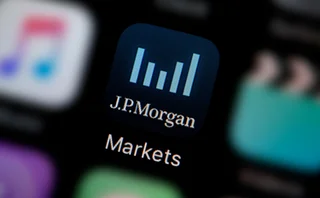
Shedding the correlation ‘axe’
Sophisticated structured equity derivatives houses have shed up to 10% of their short correlation risk positions to hedge funds using a new instrument called a correlation swap.

Dealers structuring equity products for retail investors have built up significant short equity correlation positions estimated to be as large as e200 million per percentage point of correlation – or e10 billion at current one-year Eurostoxx implied correlation levels.
The sheer size of these one-way positions, also termed ‘book axe’, led to fears that dealers would be forced to scale down their activity in providing retail structured products.
This potentially threatened the profitability of a number of investment banks, especially SG, which most dealers believe has the largest short correlation positions – something that became particularly acute as the equity market rally last year accentuated the short positions.
But the French bank has innovated its way out of the problem and inspired a number of its competitors to mimic its latest new trade – the correlation swap. These instruments, typically dated between one-to-three years, and priced between e250,000 to e1 million per correlation point, require the dealers to structure a bespoke basket of 10 to 35 individual names where the dealer has significant correlation risk. It then sells the risk to hedge funds, and SG has laid off as much as 20% of its short correlation risk.
SG conducted its first deal in 2002, with an undisclosed large international reinsurer. Alastair Beattie, London-based managing director of SG’s hedge funds group, says reinsurers have retreated from the market. But hedge funds, pension funds and other real-money investors have stepped in to take the other side of correlation swaps.
Unlike credit correlation trades – which some participants claim have “been done to death” – equity correlation is still relatively infrequently traded. And the correlation swaps are attractive to investors due to their exposure solely to correlation. An SG insider tells Risk that bank employees regularly buy correlation swaps.
Credit Suisse First Boston, Deutsche Bank and JP Morgan Chase have all replicated SG’s technology and actively trade correlation swaps. BNP Paribas also quotes such transactions, but Hai Dang Vu, a Paris-based senior exotic derivatives trader at the French bank, says it has yet to conduct a deal – primarily due to BNP Paribas’ relatively weak hedge funds distribution, according to one bank insider.
“The correlation swap has a very clean pay-out,” says Nick Nassuphis, head of exotic equity option trading at Credit Suisse First Boston in London. “It is a swap where the dealer receives the realised correlation of a portfolio and pays out a fixed strike,” he adds.
For example, a one-year correlation swap on the Eurostoxx 50 index might have an implied correlation of 47%. If the trade is agreed at e1 million per percentage point, the dealer would pay the hedge funds e47 million on expiry. Should the realised correlation fall during that year to 43%, the hedge fund would pay the dealer e43 million. So the trade would settle with the dealer paying the hedge fund e4 million.
However, correlation swaps focus on very bespoke baskets, not indexes. “The origin of where these trades came from is really the sales side trying to dispose of some of our risks,” says Richard Carson, Deutsche Bank’s London-based co-head of exotic equity options trading. “So we create a bespoke basket of 10-25 names where we have considerable correlation risk, then approach a client base and say, ‘this is a proposal, these are the names, are you willing to write a correlation hedge on this?’”
This intra-stock correlation sensitivity built up on dealers’ books during the past two to three years from Altiplano-style products, where a whole coupon-based structure gives a large correlation sensitivity between about 15 names. The names also tend to be global in nature, with 50% European, 30% US and 20% Asian names appearing in such structures.
“The exposures are less easy to break down in terms of an index that exists,” explains Carson. “It is by no means a Global Titans Index, so this is a way for us to buy back intra-region correlation, which otherwise is very hard for us to source.”
Carson believes dealers have reduced about 10% of the industry’s total short correlation ‘axe’ through the use of correlation swaps. He says other methods of shedding short correlation, including the infrequent structuring of retail products that allow investors to buy short correlation positions, were verging on “insignificant” relative to correlation swaps.
Courting investors
To be able to shed their short correlation exposures, dealers needed to court potential investors. And their timing was good. Correlation has become an increasingly familiar concept for hedge funds trading dispersion strategies using vanilla equity options. Here an investor trades an index versus its components or a subset of it components – for example, the Eurostoxx versus its 50 underlyings or 20 of them. Dispersion trades are used by hedge funds most commonly as a vega-spread transaction with the correlation position forming an intrinsic part of the deal. “Effectively they buy options on a sub-basket of an index and short the remaining names. They are looking for relative value,” says Deutsche’s Carson. But increasingly cash-rich hedge funds – especially quantitative US funds – that have seen trading opportunities diminish in traditionally profitable areas such as convertible arbitrage are increasingly looking at straight correlation bets.
As index volatility has increased significantly relative to single-stock volatility, implied correlations have spiked sharply. The expectation is that the implied correlation level of 50% on the Eurostoxx 50 is rarely realised (see figure 1).
“We favour selling volatility at the index level and buying volatility at the single-stock level (that is, selling correlation),” said Credit Swiss First Boston equity derivatives strategy analysts in a March 16 market commentary. “Implied correlation is still rich compared with the three years prior to the equity market bubble bursting and the [most recent] Iraqi war,” adds Nassuphis.
Typically, vanilla option transactions have a listed expiry date, so there is a high level of transparency in the market and hedging is easy and relatively cheap. “The standard transaction is valued as a comparison of the at-the-money straddles on the index versus the individual stocks,” says Deutsche’s Carson. “Or equally some people are saying 90% strike in three or six months options because the implied correlation is higher at those levels.”
But gaining access to correlation transactions using vanilla options comes at a price. “You would have to do very, very large amounts of index options versus single stock to get any meaningful correlation exposure,” says CSFB’s Nassuphis. “This is especially important relative to the amount of capital at a hedge fund.”
Liquidity issues
There are also liquidity issues in some single-stock options and a need to monitor corporate actions. But perhaps the biggest cost to hedge funds is the investment required to risk-manage positions: “If the stock market moves around, you have delta and vega exposures that increases the noise around the outcomes,” adds Nassuphis. “You don’t want to be right about the correlation moves and end up losing money because you were blind to some other aspect related to the positions.”
As a result, many funds have used variance swaps to place dispersion trades. Variance swaps are useful to hedge funds as they do not need to develop the risk management and trading infrastructure required to delta hedge their positions.
“Every day you start from scratch. You see how things moved that day and chalk up a win or lose and move on to the next day until expiry,” says Nassuphis. This is appealing to fixed-income funds moving into equity correlation trading.
Another advantage to this strategy is that it is relatively easy to obtain mark-to-market valuations, as most major dealers can quote variance swaps values – issues related to ticker mismatches, the calculation of the historic volatility and scaling factors have been largely cleared up, say major dealers.
But the downside is that the use of variance swaps can prove more expensive – about 1.7% to 2% more than using vanilla instruments, according to industry participants. In addition, the whole skew of correlation is built into the pricing when using variance dispersion, whereas the implied correlation is different between strikes for vanilla options – for example the 90% strike on Eurostoxx has a higher implied correlation than the at-the-money implied correlation.
But Deutsche’s Carson believes that for hedge funds able to monitor a variance swap through its prime brokerage, it is an easier trade to put on their books when the market levels look attractive. And it is equally easy to unwind. “Using a variance dispersion, one can quite visually see how much money it has made,” says Carson. “Whereas dispersion through vanillas doesn’t just stare at you and say you have made three correlation vega points.”
Tim Hart, head of institutional sales at Deutsche Bank’s equity derivatives group in London, believes the various ways of gaining correlation exposure appeal to different types of hedge funds. “The more market trading hedge funds such as a convertible arbitrage or long/short equity-type strategies would be more disposed to just simple dispersion. It is something that they feel comfortable trading,” says Hart. “Whereas the variance swap approach seems to be much more appealing to ex-proprietary trading people that have the sophisticated background and systems to monitor those positions.”
He says that even when the variance approach is more attractive than vanilla dispersion trading, market-trading funds are still not interested. “They feel there is not enough liquidity or transparency in the market, although that is clearly changing as volumes in the variance market multiply,” he adds.
Illiquidity issues
But the purest way to take a correlation position is through correlation swaps. They are also the only way to gain direct longer-dated exposure – one-to-three years versus less-than-a-year for variance swaps. The main downside is that they are extremely illiquid products that are hard to mark-to-market. They are also tricky investments for funds whose investors gauge their performance over a short time horizon of up to a year.
“You find funds that may prefer a correlation swap from an ‘efficiency of expression’ perspective but tend to use variance trades rather than correlation swaps because that is compatible with their accounting requirements,” says CSFB’s Nassuphis.
But Deutsche’s Carson believes the auto-hedging aspect of correlation swaps is compelling. “It doesn’t require hedging on the close, it is purely going to give you the analytic formula for a pay-out. This makes it easy from a scaling point of view, and has the benefit of lack of market impact from a pension fund or hedge fund point of view. This has been one of the drivers for our clients,” he says.
However, the degree to which dealers are looking to buy back this correlation sensitivity is a little varied. “As specific names perform or underperform, the correlation sensitivity that exists on these products varies to quite a large degree,” says Carson. “For example, as the stock knocks out one of the coupons and is removed from a basket, then clearly there is no longer a correlation sensitivity to that particular stock.”
Unlike European options, where the gamma profile is linked to strikes, correlation swaps offer constant correlation sensitivity regardless of underlying equities moves – they are lever-independent. Dealers say this is why a three-year rather than five-year market has developed. Essentially dealers, due to their selection procedures, expect a lot of the initial stocks sold in structured products to be deleted after five years.
“A lot of people are still happy with the level of shorter-dated correlation they have sold,” says Deutsche Bank’s Hart. “They see it as an interesting trading axe, so buying back correlation arguably takes away some rather nice positions.” For example, when Finnish telecommunications company Nokia reported that first-quarter sales fell 2%, causing its share price to tumble 15% to e14.70 on April 6, with only a corresponding 0.9% fall in the Eurostoxx index – a relatively uncorrelated move – dealers’ short correlation made money.
“Nokia has been quite a popular stock to use in retail products due to its volatility levels,” says Hart. “The recent uncorrelated volatile stock moves have been a good source of profitability. If you buy a lot of correlation back you will end up without these rather nice trading positions.”
Hart also indicated that dealers’ willingness to shed their shorter-dated correlation axe has diminished somewhat in the first quarter of this year. Both implied correlation and realised correlation levels have fallen since December 2003. The main factor stems from insurance companies, which had built up huge hedge positions against equity decline last year, not rolling over their downside puts into 2004.
“The removal, especially of that phenomenon of downside short-gamma out of the index market, put correlation into free-fall,” Hart says. “Significant gains have been had by those dealers short correlation in the first quarter, so the demand to offset that risk now compared to last year is less,” he adds.
SG’s Beattie says the French bank is also happy keeping a large chunk of its short correlation positions. But CSFB’s Nassuphis sees the situation somewhat differently: “Exotic option desks are single-strategy enterprises – they have one exposure and suffer if things go wrong,” he says. “Whereas hedge funds tend to be multi-strategy, which means they are better able to carry that type of risk as they have off-setting strategies.”
Dealers also have slightly different views on the future development of the market. JP Morgan Chase, for example, expects a few more dealers and many more hedge funds to trade correlation swaps. It also expects a trend of smaller dealers using large houses to help them shed their short positions.
“We want to provide a two-way market,” says Chris French, head of trading for hybrid and exotic equity and credit derivatives at JP Morgan in London. “Our motive is to foster a correlation market-place where institutions, big or small, can offset their risks in a very transparent way,” he adds. French says JP Morgan has acted on the behalf of at least one smaller retail structured product house.
This scenario appears logical. The investment and time it takes to put systems in place and analyse the risk is significant. “It is a different style of exposure compared with your exotic trades,” says CSFB’s Nassuphis. “The correlation exposure from your exotic desk is dynamic. The sensitivity to various names moves around as the names move around, and the size of the correlation exposure changes with the market’s volatility levels. It takes a lot of time to get comfortable with that.”
SG’s Beattie believes it is unlikely that a liquid market will emerge: “It is an area where different people are looking at it, but probably not enough to make a liquid market. But correlation trading through variance swaps – that is something that is becoming more and more common.” Nonetheless, correlation swaps have proven a vital risk management tool for structured product houses.
Only users who have a paid subscription or are part of a corporate subscription are able to print or copy content.
To access these options, along with all other subscription benefits, please contact info@risk.net or view our subscription options here: http://subscriptions.risk.net/subscribe
You are currently unable to print this content. Please contact info@risk.net to find out more.
You are currently unable to copy this content. Please contact info@risk.net to find out more.
Copyright Infopro Digital Limited. All rights reserved.
You may share this content using our article tools. Printing this content is for the sole use of the Authorised User (named subscriber), as outlined in our terms and conditions - https://www.infopro-insight.com/terms-conditions/insight-subscriptions/
If you would like to purchase additional rights please email info@risk.net
Copyright Infopro Digital Limited. All rights reserved.
You may share this content using our article tools. Copying this content is for the sole use of the Authorised User (named subscriber), as outlined in our terms and conditions - https://www.infopro-insight.com/terms-conditions/insight-subscriptions/
If you would like to purchase additional rights please email info@risk.net
More on Markets
Buy side would welcome more guidance on managing margin calls
FSB report calls for regulators to review existing standards for non-bank liquidity management
Citi halves swaptions book with US retail funds
Counterparty Radar: Mutual funds and ETFs cut exposures by 22% in Q4
Who’s winning the €STR futures race? Depends how you measure
CME, Eurex and Ice all claim to be leading, but experts say it’s too early to pick a winner
CDS review seeks to tackle conflicts ‘elephant’
Isda AGM: Linklaters proposes overhaul for determinations committee - including independent members
Saudi Arabia poised to become clean netting jurisdiction
Isda AGM: Netting regulation awaiting final approvals from regulators
Buy side looks to fill talent gap in yen rates trading
Isda AGM: Japan rate rises spark demand for traders; dealers say inexperience could trigger volatility
JP Morgan’s new way to trade FX overlays
Hybrid execution method allows clients to put dealers in competition via a single trading agreement
Pension funds eye 30-year Bunds as swap spread tightens
Long-dated bonds continue to cheapen versus euro swaps, and some think they might fall further
Most read
- Top 10 operational risks for 2024
- Top 10 op risks: third parties stoke cyber risk
- Japanese megabanks shun internal models as FRTB bites







